air condition FIAT 124 SPIDER 2018 Owner handbook (in English)
[x] Cancel search | Manufacturer: FIAT, Model Year: 2018, Model line: 124 SPIDER, Model: FIAT 124 SPIDER 2018Pages: 220, PDF Size: 3.18 MB
Page 34 of 220
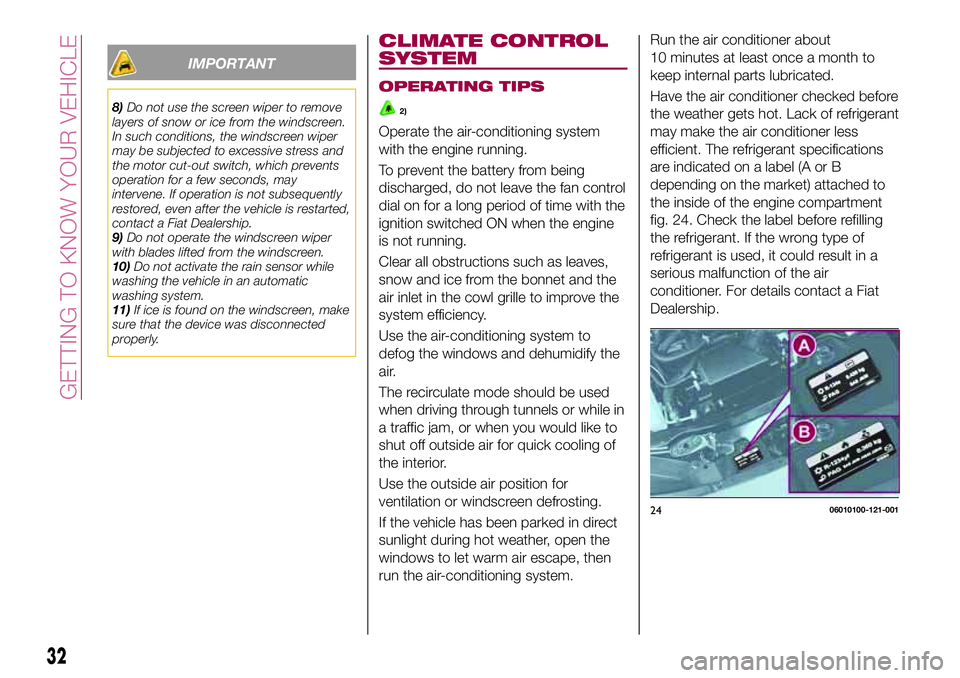
IMPORTANT
8)Do not use the screen wiper to remove
layers of snow or ice from the windscreen.
In such conditions, the windscreen wiper
may be subjected to excessive stress and
the motor cut-out switch, which prevents
operation for a few seconds, may
intervene. If operation is not subsequently
restored, even after the vehicle is restarted,
contact a Fiat Dealership.
9)Do not operate the windscreen wiper
with blades lifted from the windscreen.
10)Do not activate the rain sensor while
washing the vehicle in an automatic
washing system.
11)If ice is found on the windscreen, make
sure that the device was disconnected
properly.
CLIMATE CONTROL
SYSTEM
OPERATING TIPS
2)
Operate the air-conditioning system
with the engine running.
To prevent the battery from being
discharged, do not leave the fan control
dial on for a long period of time with the
ignition switched ON when the engine
is not running.
Clear all obstructions such as leaves,
snow and ice from the bonnet and the
air inlet in the cowl grille to improve the
system efficiency.
Use the air-conditioning system to
defog the windows and dehumidify the
air.
The recirculate mode should be used
when driving through tunnels or while in
a traffic jam, or when you would like to
shut off outside air for quick cooling of
the interior.
Use the outside air position for
ventilation or windscreen defrosting.
If the vehicle has been parked in direct
sunlight during hot weather, open the
windows to let warm air escape, then
run the air-conditioning system.Run the air conditioner about
10 minutes at least once a month to
keep internal parts lubricated.
Have the air conditioner checked before
the weather gets hot. Lack of refrigerant
may make the air conditioner less
efficient. The refrigerant specifications
are indicated on a label (A or B
depending on the market) attached to
the inside of the engine compartment
fig. 24. Check the label before refilling
the refrigerant. If the wrong type of
refrigerant is used, it could result in a
serious malfunction of the air
conditioner. For details contact a Fiat
Dealership.
2406010100-121-001
32
GETTING TO KNOW YOUR VEHICLE
Page 37 of 220
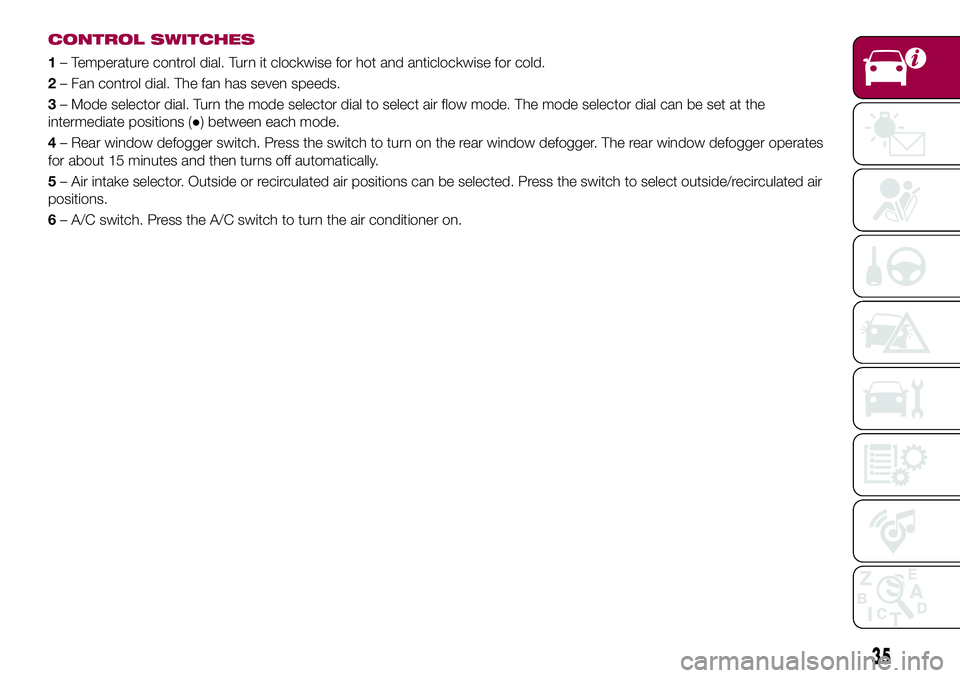
CONTROL SWITCHES
1– Temperature control dial. Turn it clockwise for hot and anticlockwise for cold.
2– Fan control dial. The fan has seven speeds.
3– Mode selector dial. Turn the mode selector dial to select air flow mode. The mode selector dial can be set at the
intermediate positions (●) between each mode.
4– Rear window defogger switch. Press the switch to turn on the rear window defogger. The rear window defogger operates
for about 15 minutes and then turns off automatically.
5– Air intake selector. Outside or recirculated air positions can be selected. Press the switch to select outside/recirculated air
positions.
6– A/C switch. Press the A/C switch to turn the air conditioner on.
35
Page 39 of 220

CONTROL SWITCHES
1– Temperature control dial.
2– Fan control dial. The fan has seven speeds.AUTO position: the amount of air flow will be automatically controlled in
accordance with the set temperature.Except AUTO position: the air flow amount can be adjusted to the desired level by
turning the dial.0 position: to turn off the system, set the dial to 0 position.
3– Mode selector dial. Turn the mode selector dial to select air flow mode.AUTO position: the air flow mode automatically
adjusts to the selected temperature. Except AUTO position: the desired air flow position can be selected by turning the dial.
4– Rear window defogger switch. Press the switch to turn on the rear window defogger. The rear window defogger operates
for about 15 minutes and then turns off automatically.
5– Air intake selector. Outside or recirculated air positions can be selected. Press the switch to select outside/recirculated air
positions.
6– A/C switch. The air conditioning (cooling/dehumidifying functions) can be turned on or off by pressing the switch while the
fan control dial is at a position other than 0.
37
Page 60 of 220
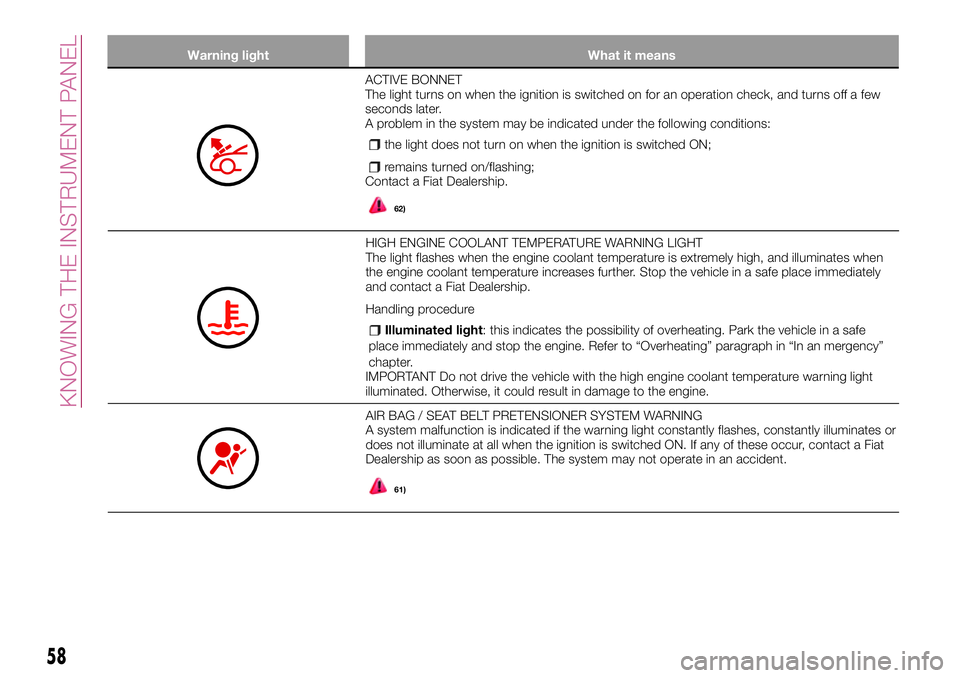
Warning light What it means
ACTIVE BONNET
The light turns on when the ignition is switched on for an operation check, and turns off a few
seconds later.
A problem in the system may be indicated under the following conditions:
the light does not turn on when the ignition is switched ON;
remains turned on/flashing;Contact a Fiat Dealership.
62)
HIGH ENGINE COOLANT TEMPERATURE WARNING LIGHT
The light flashes when the engine coolant temperature is extremely high, and illuminates when
the engine coolant temperature increases further. Stop the vehicle in a safe place immediately
and contact a Fiat Dealership.
Handling procedure
Illuminated light: this indicates the possibility of overheating. Park the vehicle in a safe
place immediately and stop the engine. Refer to “Overheating” paragraph in “In an mergency”
chapter.
IMPORTANT Do not drive the vehicle with the high engine coolant temperature warning light
illuminated. Otherwise, it could result in damage to the engine.
AIR BAG / SEAT BELT PRETENSIONER SYSTEM WARNING
A system malfunction is indicated if the warning light constantly flashes, constantly illuminates or
does not illuminate at all when the ignition is switched ON. If any of these occur, contact a Fiat
Dealership as soon as possible. The system may not operate in an accident.
61)
58
KNOWING THE INSTRUMENT PANEL
Page 70 of 220

MESSAGE INDICATED ON
DISPLAY
(versions with Radio 7”)
If a message is displayed in the center
display, take appropriate action (in a
calm manner) according to the
displayed message.
If the following messages are displayed
in the centre display, a vehicle system
may be malfunctioning:
Engine Coolant Temperature
High: displays if the engine coolant
temperature has increased excessively.
Changing System Malfunction:
displays if the charging system has a
malfunction.
Temperature Warning: the
following message is displayed when
the temperature around the centre
display is high. Lowering the
temperature in the cabin or the
temperature around the centre display
by avoiding direct sunlight is
recommended.
Stop the vehicle in a safe place and
contact a Fiat Dealership.
WARNING SOUND IS
ACTIVATED
A warning sound is activated in
following cases:
Lights-on reminder;
Air Bag/seat belt pretensioner
system;
Active bonnet (where provided);
Ignition not switched off (STOP);
Key removed from vehicle;
"Door locking" switch inoperable
(versions with advanced keyless function);
Key left-in-boot compartment
(versions with advanced keyless
function);
Key left-in-vehicle (versions with
advanced keyless function);
Vehicle speed alarm (where
provided);
Tire inflation pressure warning beep
(where provided);
Outside temperature (where
provided);
Electronic steering lock;
Speed limiter (where provided);
120 km/h warning (where provided).
WARNING
61)Never tamper with the air
bag/pretensioner systems and always
contact a Fiat Dealership perform all
servicing and repairs. Self-servicing or
tampering with the systems is dangerous.
An air bag/pretensioner could accidentally
activate or become disabled causing
serious injury or death.62)Do not drive the vehicle with the active
bonnet warning light turned on or flashing.
Driving the vehicle with the active hood
warning light turned on or flashing is
dangerous as the active hood mechanism
may not activate normally and function as
intended in the event the vehicle were to
contact a pedestrian.
63)If the TPMS warning light illuminates or
flashes, or the tire pressure warning beep
sound is heard, decrease vehicle speed
immediately and avoid sudden
maneuvering and braking. If the warning
light illuminates or flashes, or the tire
pressure warning beep sound is heard, it is
dangerous to drive the vehicle at high
speeds, or perform sudden maneuvering
or braking. Vehicle drivability could worsen
and result in an accident. To determine if
you have a slow leak or a flat, pull over to a
safe position where you can check the
visual condition of the tire and determine if
you have enough air to proceed to a place
where air may be added and the system
monitored again by Fiat Dealership or a tire
repair station.
64)Do not ignore the TPMS warning light.
Ignoring the TPMS warning light is
dangerous, even if you know why it is
illuminated. Have the problem taken care of
as soon as possible before it develops into
a more serious situation that could lead to
tire failure and a dangerous accident.
68
KNOWING THE INSTRUMENT PANEL
Page 74 of 220
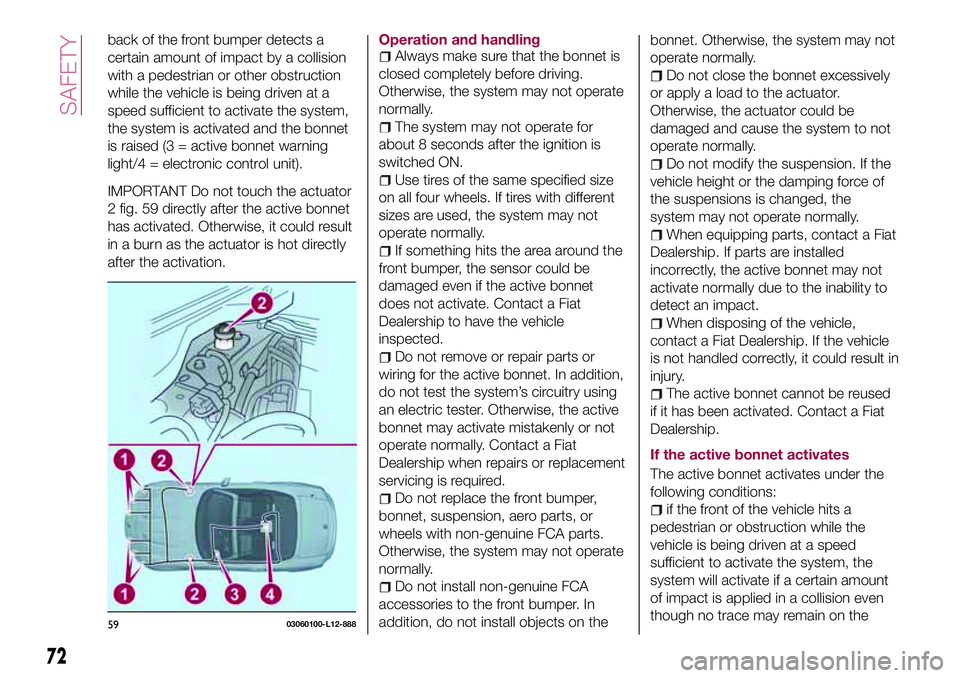
back of the front bumper detects a
certain amount of impact by a collision
with a pedestrian or other obstruction
while the vehicle is being driven at a
speed sufficient to activate the system,
the system is activated and the bonnet
is raised (3 = active bonnet warning
light/4 = electronic control unit).
IMPORTANT Do not touch the actuator
2 fig. 59 directly after the active bonnet
has activated. Otherwise, it could result
in a burn as the actuator is hot directly
after the activation.
Operation and handlingAlways make sure that the bonnet is
closed completely before driving.
Otherwise, the system may not operate
normally.
The system may not operate for
about 8 seconds after the ignition is
switched ON.
Use tires of the same specified size
on all four wheels. If tires with different
sizes are used, the system may not
operate normally.
If something hits the area around the
front bumper, the sensor could be
damaged even if the active bonnet
does not activate. Contact a Fiat
Dealership to have the vehicle
inspected.
Do not remove or repair parts or
wiring for the active bonnet. In addition,
do not test the system’s circuitry using
an electric tester. Otherwise, the active
bonnet may activate mistakenly or not
operate normally. Contact a Fiat
Dealership when repairs or replacement
servicing is required.
Do not replace the front bumper,
bonnet, suspension, aero parts, or
wheels with non-genuine FCA parts.
Otherwise, the system may not operate
normally.
Do not install non-genuine FCA
accessories to the front bumper. In
addition, do not install objects on thebonnet. Otherwise, the system may not
operate normally.
Do not close the bonnet excessively
or apply a load to the actuator.
Otherwise, the actuator could be
damaged and cause the system to not
operate normally.
Do not modify the suspension. If the
vehicle height or the damping force of
the suspensions is changed, the
system may not operate normally.
When equipping parts, contact a Fiat
Dealership. If parts are installed
incorrectly, the active bonnet may not
activate normally due to the inability to
detect an impact.
When disposing of the vehicle,
contact a Fiat Dealership. If the vehicle
is not handled correctly, it could result in
injury.
The active bonnet cannot be reused
if it has been activated. Contact a Fiat
Dealership.
If the active bonnet activates
The active bonnet activates under the
following conditions:
if the front of the vehicle hits a
pedestrian or obstruction while the
vehicle is being driven at a speed
sufficient to activate the system, the
system will activate if a certain amount
of impact is applied in a collision even
though no trace may remain on the
5903060100-L12-888
72
SAFETY
Page 77 of 220
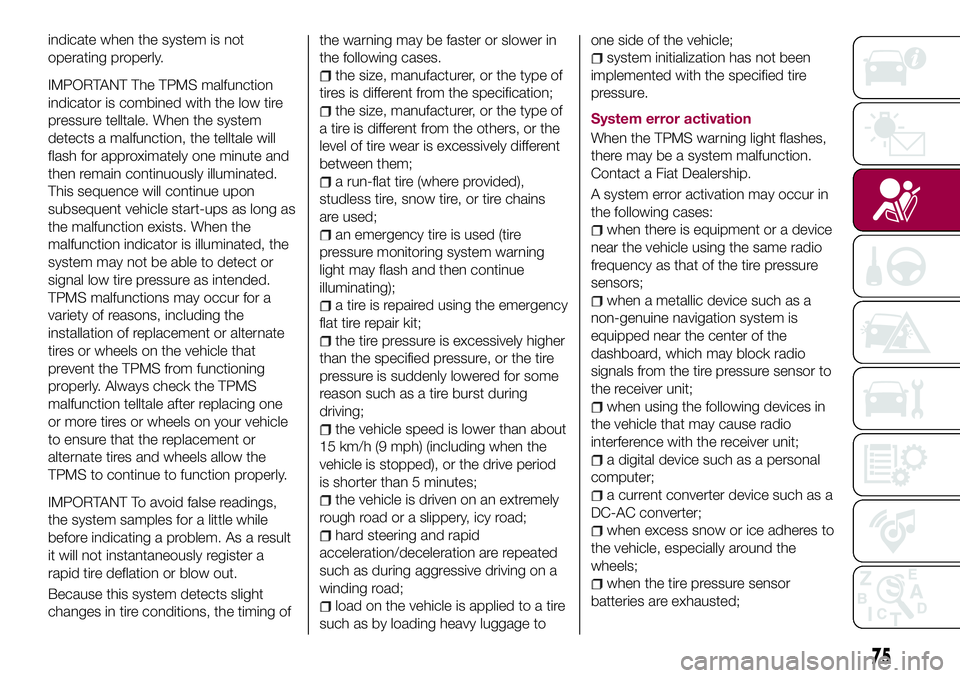
indicate when the system is not
operating properly.
IMPORTANT The TPMS malfunction
indicator is combined with the low tire
pressure telltale. When the system
detects a malfunction, the telltale will
flash for approximately one minute and
then remain continuously illuminated.
This sequence will continue upon
subsequent vehicle start-ups as long as
the malfunction exists. When the
malfunction indicator is illuminated, the
system may not be able to detect or
signal low tire pressure as intended.
TPMS malfunctions may occur for a
variety of reasons, including the
installation of replacement or alternate
tires or wheels on the vehicle that
prevent the TPMS from functioning
properly. Always check the TPMS
malfunction telltale after replacing one
or more tires or wheels on your vehicle
to ensure that the replacement or
alternate tires and wheels allow the
TPMS to continue to function properly.
IMPORTANT To avoid false readings,
the system samples for a little while
before indicating a problem. As a result
it will not instantaneously register a
rapid tire deflation or blow out.
Because this system detects slight
changes in tire conditions, the timing ofthe warning may be faster or slower in
the following cases.
the size, manufacturer, or the type of
tires is different from the specification;
the size, manufacturer, or the type of
a tire is different from the others, or the
level of tire wear is excessively different
between them;
a run-flat tire (where provided),
studless tire, snow tire, or tire chains
are used;
an emergency tire is used (tire
pressure monitoring system warning
light may flash and then continue
illuminating);
a tire is repaired using the emergency
flat tire repair kit;
the tire pressure is excessively higher
than the specified pressure, or the tire
pressure is suddenly lowered for some
reason such as a tire burst during
driving;
the vehicle speed is lower than about
15 km/h (9 mph) (including when the
vehicle is stopped), or the drive period
is shorter than 5 minutes;
the vehicle is driven on an extremely
rough road or a slippery, icy road;
hard steering and rapid
acceleration/deceleration are repeated
such as during aggressive driving on a
winding road;
load on the vehicle is applied to a tire
such as by loading heavy luggage toone side of the vehicle;
system initialization has not been
implemented with the specified tire
pressure.
System error activation
When the TPMS warning light flashes,
there may be a system malfunction.
Contact a Fiat Dealership.
A system error activation may occur in
the following cases:
when there is equipment or a device
near the vehicle using the same radio
frequency as that of the tire pressure
sensors;
when a metallic device such as a
non-genuine navigation system is
equipped near the center of the
dashboard, which may block radio
signals from the tire pressure sensor to
the receiver unit;
when using the following devices in
the vehicle that may cause radio
interference with the receiver unit;
a digital device such as a personal
computer;
a current converter device such as a
DC-AC converter;
when excess snow or ice adheres to
the vehicle, especially around the
wheels;
when the tire pressure sensor
batteries are exhausted;
75
Page 84 of 220
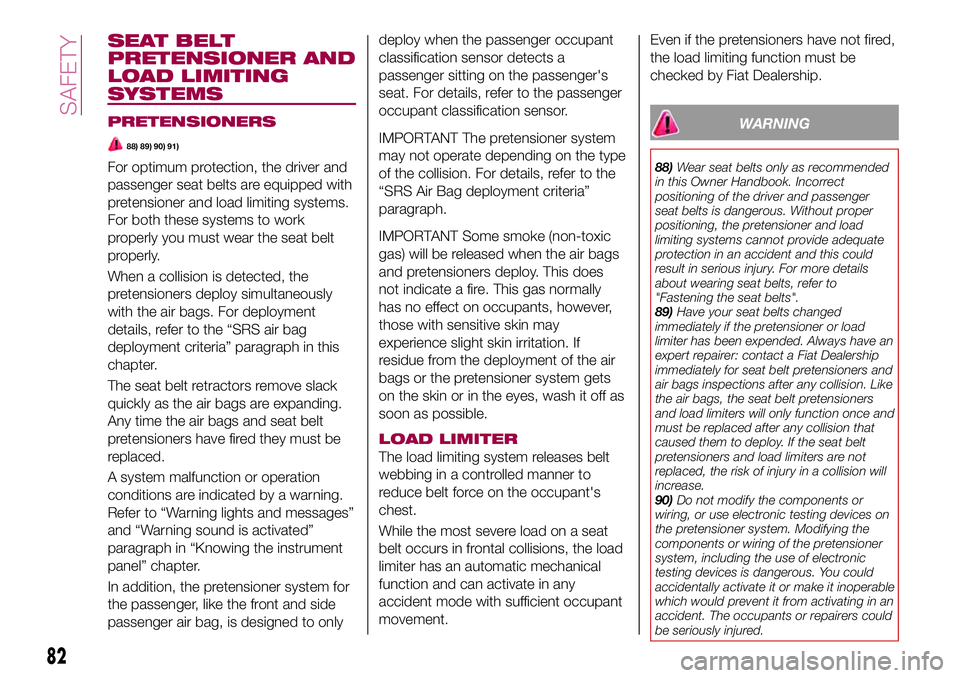
SEAT BELT
PRETENSIONER AND
LOAD LIMITING
SYSTEMS
PRETENSIONERS
88) 89) 90) 91)
For optimum protection, the driver and
passenger seat belts are equipped with
pretensioner and load limiting systems.
For both these systems to work
properly you must wear the seat belt
properly.
When a collision is detected, the
pretensioners deploy simultaneously
with the air bags. For deployment
details, refer to the “SRS air bag
deployment criteria” paragraph in this
chapter.
The seat belt retractors remove slack
quickly as the air bags are expanding.
Any time the air bags and seat belt
pretensioners have fired they must be
replaced.
A system malfunction or operation
conditions are indicated by a warning.
Refer to “Warning lights and messages”
and “Warning sound is activated”
paragraph in “Knowing the instrument
panel” chapter.
In addition, the pretensioner system for
the passenger, like the front and side
passenger air bag, is designed to onlydeploy when the passenger occupant
classification sensor detects a
passenger sitting on the passenger's
seat. For details, refer to the passenger
occupant classification sensor.
IMPORTANT The pretensioner system
may not operate depending on the type
of the collision. For details, refer to the
“SRS Air Bag deployment criteria”
paragraph.
IMPORTANT Some smoke (non-toxic
gas) will be released when the air bags
and pretensioners deploy. This does
not indicate a fire. This gas normally
has no effect on occupants, however,
those with sensitive skin may
experience slight skin irritation. If
residue from the deployment of the air
bags or the pretensioner system gets
on the skin or in the eyes, wash it off as
soon as possible.
LOAD LIMITER
The load limiting system releases belt
webbing in a controlled manner to
reduce belt force on the occupant's
chest.
While the most severe load on a seat
belt occurs in frontal collisions, the load
limiter has an automatic mechanical
function and can activate in any
accident mode with sufficient occupant
movement.Even if the pretensioners have not fired,
the load limiting function must be
checked by Fiat Dealership.
WARNING
88)Wear seat belts only as recommended
in this Owner Handbook. Incorrect
positioning of the driver and passenger
seat belts is dangerous. Without proper
positioning, the pretensioner and load
limiting systems cannot provide adequate
protection in an accident and this could
result in serious injury. For more details
about wearing seat belts, refer to
"Fastening the seat belts".
89)Have your seat belts changed
immediately if the pretensioner or load
limiter has been expended. Always have an
expert repairer: contact a Fiat Dealership
immediately for seat belt pretensioners and
air bags inspections after any collision. Like
the air bags, the seat belt pretensioners
and load limiters will only function once and
must be replaced after any collision that
caused them to deploy. If the seat belt
pretensioners and load limiters are not
replaced, the risk of injury in a collision will
increase.
90)Do not modify the components or
wiring, or use electronic testing devices on
the pretensioner system. Modifying the
components or wiring of the pretensioner
system, including the use of electronic
testing devices is dangerous. You could
accidentally activate it or make it inoperable
which would prevent it from activating in an
accident. The occupants or repairers could
be seriously injured.
82
SAFETY
Page 96 of 220

94)Always secure a child in a proper
child-restraint system. Holding a child in
your arms while the vehicle is moving is
extremely dangerous. No matter how
strong the person may be, he or she
cannot hold onto a child in a sudden stop
or collision and it could result in serious
injury or death to the child or other
occupants. Even in a moderate accident,
the child may be exposed to air bag forces
that could result in serious injury or death
to the child, or the child may be slammed
into an adult, causing injury to both child
and adult.
95)Always make sure the passenger air
bag deactivation OFF indicator light is
illuminated when using a child restraint
system. Seating a child in a child restraint
system that is installed on the passenger
seat with the passenger air bag
deactivation OFF indicator light not
illuminated is extremely dangerous. In an
accident, an air bag could inflate and
cause serious injuries or even death to the
child seated in the child restraint system.
Always make sure the passenger air bag
deactivation OFF indicator light is
illuminated.
96)Extreme Hazard! Never use a
rear-facing child-restraint system on the
passenger seat with an air bag that could
deploy: NEVER use a rearward facing child
restraint on a seat protected by an ACTIVE
AIRBAG in front of it, DEATH or SERIOUS
INJURY to the CHILD can occur. Vehicles
with a passenger air bag have a warning
label attached as shown below. This
warning label is displayed in compliance
with regulations.97)Even in a moderate collision, the
child-restraint system can be hit by a
deploying air bag and moved violently
backward resulting in serious injury or
death to the child. If your vehicle is
equipped with a passenger occupant
classification system, always make sure the
passenger air bag deactivation OFF
indicator light is illuminated, when installing
a rear-facing child restraint system on the
passenger seat.
98)Before installing child-restraint system
on the passenger seat, move the
passenger seat as far back as possible.
The rearmost position may not be suitable
for the installation of some child-restraint
systems. In a collision, the force of a
deploying air bag could cause serious
injury or death to the child. Make sure the
passenger air bag deactivation OFF
indicator light is illuminated.99)Seating a child in a child-restraint
system on the passenger seat is
dangerous under certain conditions. Your
vehicle is equipped with passenger
occupant classification sensor. Even with
the passenger occupant classification
sensor, if you must use the passenger seat
to seat a child, using a child restraint
system on the passenger seat under the
following conditions increases the danger
of the passenger air bag deploying and
could result in serious injury or death to the
child. The passenger air bag deactivation
OFF indicator light does not illuminate
when seating a child in the child-restraint
system / Luggage or other items are
placed on the seat with the child in the
child-restraint system / The seat is washed
/ Liquids are spilled on the seat / The
passenger seat is moved backward,
pushing into luggage or other items placed
behind it / Luggage or other items are
placed between the passenger seat and
driver seat / An electric device is put on the
passenger's seat / An additional electrical
device, such as a seat warmer is installed
to the surface of the passenger seat.
94
SAFETY
Page 101 of 220
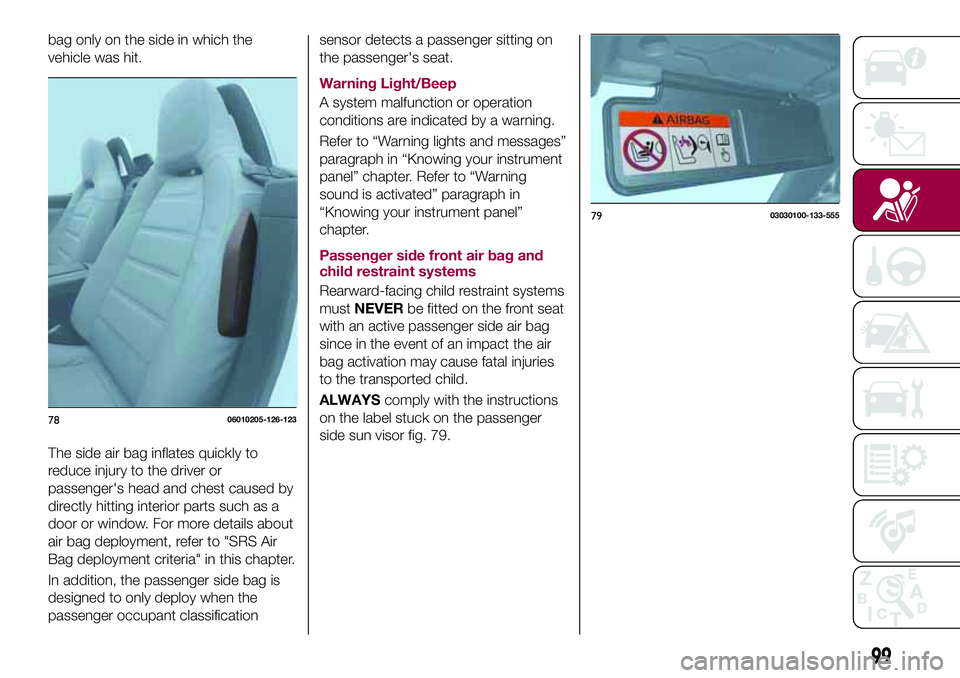
bag only on the side in which the
vehicle was hit.
The side air bag inflates quickly to
reduce injury to the driver or
passenger's head and chest caused by
directly hitting interior parts such as a
door or window. For more details about
air bag deployment, refer to "SRS Air
Bag deployment criteria" in this chapter.
In addition, the passenger side bag is
designed to only deploy when the
passenger occupant classificationsensor detects a passenger sitting on
the passenger's seat.
Warning Light/Beep
A system malfunction or operation
conditions are indicated by a warning.
Refer to “Warning lights and messages”
paragraph in “Knowing your instrument
panel” chapter. Refer to “Warning
sound is activated” paragraph in
“Knowing your instrument panel”
chapter.
Passenger side front air bag and
child restraint systems
Rearward-facing child restraint systems
mustNEVERbe fitted on the front seat
with an active passenger side air bag
since in the event of an impact the air
bag activation may cause fatal injuries
to the transported child.
ALWAYScomply with the instructions
on the label stuck on the passenger
side sun visor fig. 79.
7806010205-126-123
7903030100-133-555
99